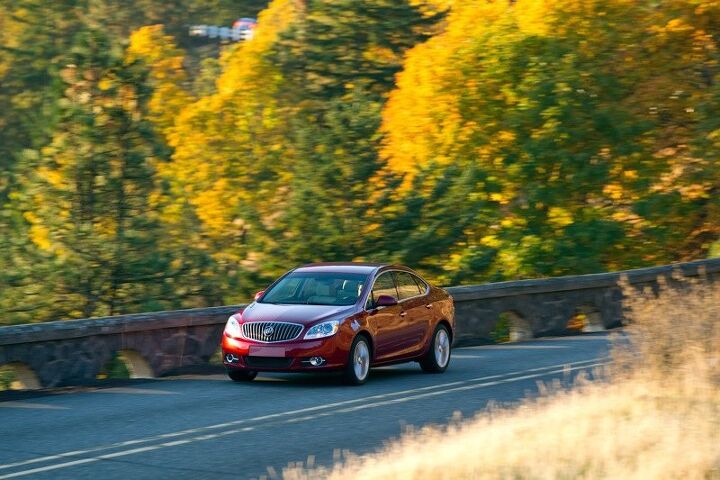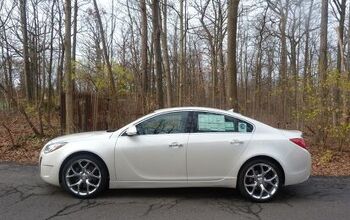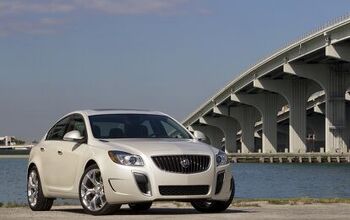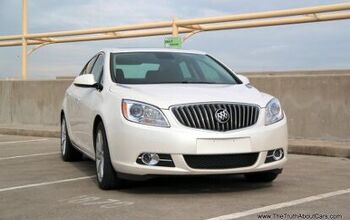Review: 2012 Buick Verano
In a luxury market that’s always looking for the next big thing, “Compact Luxury” has become something of a hot trend. And with GM’s Buick brand saved from the bailout-era brand cull, a compact Buick is a key test of whether The General has moved past its bad habits of cynical badge engineering. Thus the 2012 Buick Verano is a hugely important car to The General, not only serving as a bellweather for the health of the Buick brand, but also proving whether or not GM “gets” the tough-to-crack entry-luxury market. So, does the Verano measure up?
From the get-go, it’s clear that GM wanted the Verano to be a clean break from its ignominious past of rebadging Chevy compacts. In sharp contrast from Buick’s last compact, the Skylark which died out in 1998, the Verano hides its Chevrolet roots well from the outside. With only a subtle “hockey stick” character line betraying its Opel roots, the Verano is neither a rebadged Euro-market sedan (like the Regal) nor a “pure” Buick design like the LaCrosse. But it does split the difference between the two designs, marrying a subtle design with a few discrete Buick cues like the hood-mounted ventiports. The overall impression is of a clean, classy car that is, if anything, possibly a bit too substantial and anonymous… which, upon further reflection, makes it quite Buick-like.
Inside, GM’s newfound parts-bin savvy takes center stage: just as the Regal was rebadged from a different market, the Verano’s interior is borrowed but not duplicative. The seats, which are some of the best available in the compact class, are the huge, well-bolstered thrones from the LaCrosse. The IP, which is visually and ergonomically more approachable than the somber, button-laden Regal unit, is borrowed (with a few modifications) from the Opel Astra… which just so happens to be getting a new sedan variant soon. Especially in the warmer, lighter shades that Buick makes available, the soft-touch interior with its subtle chrome accents makes even the LTZ Cruze seem a bit cold and cheesy.
On the other hand, I do have one beef on the materials front. At Chevy’s Centennial event in Detroit a Chevy interior specialist told me that GM’s mass-market brand was moving away from “materials that look like something they’re not,” a direction I find highly laudable. Sadly, GM’s “thoughtful luxury” brand is a bit behind the curve in this respect, employing great swaths of brushed-nickle-look plastic around the IP and elsewhere. Though it looks good from a distance, it takes only the most superficial contact (or even thought) to realize that it’s just another hard plastic. In an interior that otherwise hits its cues well, this is something of a letdown, especially from a brand that seeks to emphasize subtlety and substance.
With the Cruze already earning accolades for being one of the most quiet and refined cars in the Compact segment, one had to wonder just how far GM would go to differentiate the Verano in this respect. The answer: much farther than you’d think. The Verano is packed with more sound-deadening foams and sealants than a Guantanamo Bay interrogation room, adding several hundred 10-15 pounds to its weight (additional weight increases compared to Cruze come from wheels, drivetrain, and additional length, say Buick reps) but delivering a shockingly quiet cabin. Puttering around town in a deathly silence, I rolled my window down a few times for contrast, and was blown away at the wealth of aural feedback that would flood in only to be blocked when I rolled the window back up again. If you’re looking for a quiet compact, you’d be hard pressed to find a more effectively isolating model than the Verano.
That principle applies to the Verano’s 2.4 liter inline four-cylinder as well. Though frequent drivers of GM products will recognize the unmistakable buzz of an Ecotec under the hood, a special airbox gives the mill a more refined, intake-dominated engine note. Though I’d stop short of calling it musical, it sounds and feels considerably more sweet than any other Ecotec, especially at higher RPMs. Which is where you’ll probably spend quite a bit of time: though this 2.4 also does service in the larger Regal and Malibu sedans, it still has to work hard to hustle 3,300+ lbs of compact car around. Stuck behind a log truck on one of Oregon’s winding two-lane country roads? Make sure you have plenty of room and time to pass, as pickup is adequate rather than luxurious. On the other hand, if you kick back and cruise, said truck could jake-brake for miles without ever disturbing the cabin’s serene ambience.
Normally a Buick tuned for quiet, refined cruising would not be let down by weakness in the engine room. But strangely, the Verano has far more responsive (even twitchy) steering than you might expect, and it rotates around its short wheelbase to an extent that surprises… even coming from the more sport-oriented Regal. Though I personally prefer the Regal, the Verano can be even more fun than a base Regal, which is even more let down by the underwhelming 2.4. There’s no hiding the Verano’s heft, and too much fun will leave it a bit breathless, but there’s more directness and feel from the ZF electric steering rack than you might expect. If you’re looking for some real sport to go with your compact luxury, the Verano may not quite fit the bill… but a forthcoming Verano Coupe is starting to look quite promising.
Perhaps what makes the Verano feel more sporty than I expected is the simple fact that it’s a compact car… because from the driver’s seat it doesn’t feel like one. There’s a good impression of space up front, and the LaCrosse-sourced seats are large and excellent. Unfortunately, the large size of those front seats do cut back on rear-seat legroom, which loses an inch and a half compared to the Cruze (front and rear combined legroom is 76 inches, the same as an Audi A3). As a result, the rear seat impression is considerably less luxurious and less Buick-like than the front-row experience. Is this the price of entry into the compact luxury field?
This brings up another important question, and one that gets to the heart of the Verano’s most basic flaw: why do buyers want a smaller luxury car? Though marketers may bring up a number of reasons, it seems the most key consideration is fuel economy rather than smallness for its own sake. And here the Verano lets down its entire mission: 21/31 (city/highway, GM’s estimate) isn’t even competitive for a midsized car, let alone a compact. For comparison, Audi’s A6, Chrysler’s 300 V6, and BMW’s 528i xDrive and 640i Convertible are all rated at 31 MPG on the freeway or better. Closer to home, Buick’s larger Regal also gets a 31 MPG freeway rating with the same 2.4 liter and even does one better on the freeway with its optional turbo engine.
Of course, the Regal is a very different car than the Verano. Whereas Buick’s compact is a quiet, comfy cruiser with an emphasis on isolation, the Regal is pure Euro-market, with its firm, flat seats, sombre interior and handling-tuned suspension. In other words, the Verano’s engineers hit their brief dead-on: they built a well-executed, refined baby Buick that avoids direct competition with other models in the range. Unfortunately, GM’s managers seemed more intent on building a compact luxury car for its own sake (or for Buick-GMC dealer throughput numbers’ sake) than really understanding why compact luxury appeals to buyers. Until Buick decides to equip Verano with its EcoAssist mild hybrid system, it seems to be a compact luxury car without the key appeal of its segment, namely competitive fuel economy. As the saying goes: great landing, wrong airport.
Buick made the Verano (as well as a Regal for comparison) available for this review at a media event. Buick provided lunch, and later sent a set of water glasses made from old wine bottles to me, to commemorate the event’s presence in Oregon’s Pinot Noir wine country.
More by Edward Niedermeyer
Latest Car Reviews
Read moreLatest Product Reviews
Read moreRecent Comments
- Thomas Same here....but keep in mind that EVs are already much more efficient than ICE vehicles. They need to catch up in all the other areas you mentioned.
- Analoggrotto It's great to see TTAC kicking up the best for their #1 corporate sponsor. Keep up the good work guys.
- John66ny Title about self driving cars, linked podcast about headlight restoration. Some relationship?
- Jeff JMII--If I did not get my Maverick my next choice was a Santa Cruz. They are different but then they are both compact pickups the only real compact pickups on the market. I am glad to hear that the Santa Cruz will have knobs and buttons on it for 2025 it would be good if they offered a hybrid as well. When I looked at both trucks it was less about brand loyalty and more about price, size, and features. I have owned 2 gm made trucks in the past and liked both but gm does not make a true compact truck and neither does Ram, Toyota, or Nissan. The Maverick was the only Ford product that I wanted. If I wanted a larger truck I would have kept either my 99 S-10 extended cab with a 2.2 I-4 5 speed or my 08 Isuzu I-370 4 x 4 with the 3.7 I-5, tow package, heated leather seats, and other niceties and it road like a luxury vehicle. I believe the demand is there for other manufacturers to make compact pickups. The proposed hybrid Toyota Stout would be a great truck. Subaru has experience making small trucks and they could make a very competitive compact truck and Subaru has a great all wheel drive system. Chevy has a great compact pickup offered in South America called the Montana which gm could make in North America and offered in the US and Canada. Ram has a great little compact truck offered in South America as well. Compact trucks are a great vehicle for those who want an open bed for hauling but what a smaller more affordable efficient practical vehicle.
- Groza George I don’t care about GM’s anything. They have not had anything of interest or of reasonable quality in a generation and now solely stay on business to provide UAW retirement while they slowly move production to Mexico.











































Comments
Join the conversation
I saw a Verano yesterday and it looks great! It is quite different than the Cruze. This car will be very successful and the turbo 2.0L will add something for the enthusiast.
I am a very happy owner of a 2012 Buick Verano. I have had it about a week now and this car is awesome! It's got all the comfort and style of any luxury sedan along with all the bells and whistles. It's quiet inside, seats are very comfortable with plenty of leg room in front and back. Has a spacious trunk too. The four cylinder engine has plenty of get up and go. If you haven't checked this car out in person, you won't be disappointed.